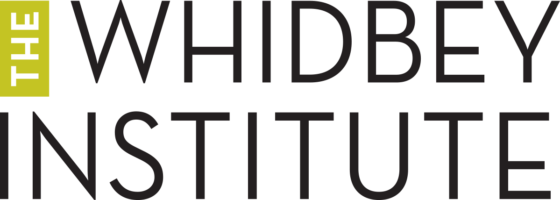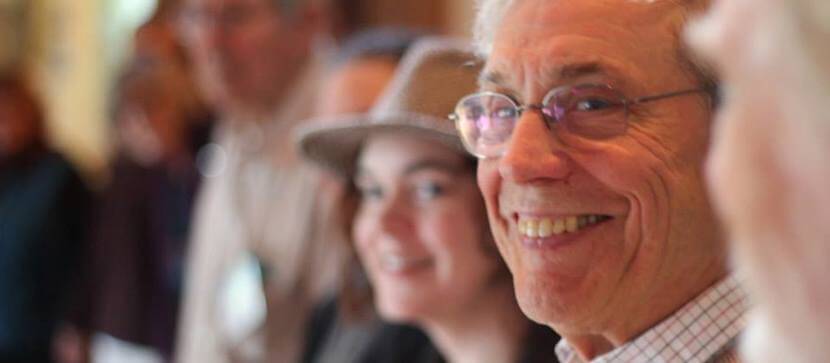As Whidbey Institute Executive Director for four transformative years, Jerry Millhon professes to have followed a cardinal rule: “hire people better than yourself.” While those of us on the staff would argue that Jerry’s a match for us all, we do see his attention to team-building bearing fruit. Most of us are here because of Jerry’s leadership, the culture he helped create, and the potential that he saw in each of us to fill the right role at the right time for the health of the whole organization.
This winter, Jerry is following his heart’s calling and stepping into Thriving Communities Initiative (TCI) program leadership—a shift which brings to a close his four years of service as Director. He and I recently spent some time together reflecting on his experience here.
Both Jerry and his late wife Kay loved, and served, the Institute during their first years on Whidbey Island—Kay as a staff member, from 1995 to 2004, and Jerry on the board, from 1995 to 2002. Thereafter, the two moved to San Francisco where Jerry took a position as Executive Director of the Foundation for Accelerated Vascular Research (now Vascular Cures). When the pair returned to Whidbey, for a volunteer assignment with the South Whidbey School District, Jerry experienced what he called, “a powerful sense of community and a feeling of coming home.”
When Jerry returned to the Institute, first in February 2010 as Interim Director and then in May 2010 in the permanent role, the organization was seeking a programmatic rudder and stability. The need for new leadership at the Institute arose at that time, and Jerry and Kay saw, “a new opportunity to see how precious this place was.””Everyone cared immensely,” he said, “but we all felt like we were seeking something just beyond our reach.” The Institute was embattled by the economic recession and a lack of clear direction, while Jerry himself was entering a time of deep, challenging experience with Kay on her journey with cancer. “When Kay and I were examining [whether my] becoming the ED was the right move for us, what we saw was not the challenge ahead,” Jerry said. “No—I saw us on the shoulders of those who had committed talents, countless hours, financial resources, and love to this place over the years . . . those who had lifted this organization up, including my wife Kay. They became vivid in my mind.” With Kay’s blessing, and in part because of their shared history with this place and the rich promise of the land, he jumped into the fray.
Jerry described his early experience as Institute Director as a blend of team-building and culture-shifting. “One cultural challenge to overcome was the feeling of scarcity,” he said. “Can you put that in the context of an abundant, loving, and wonderful place? [We were] creating a culture of financial stewardship.” With that new culture came the first team member—Wendy, in accounting—who helped the organization take its next steps toward solvency.
When it came to adding staff, Jerry said he relied first on a new core team member—Heather—who knew what they were getting into. “To do the kind of thing we were talking about, you need a critical mass of people who are really committed. Heather understood the vastness of the challenges ahead, and could see beyond the immediate horizon.” In our conversation, Jerry spoke of current and former staff members who stepped into vital roles at the right times. With credit to all the people, past and present, who helped create what we have today, Jerry described our current team of staff and board as, “diligent, competent, and able to dance together.”
“The growth of a wise, energized and productive board has been key! We have had a number of wonderful supportive board members over the years,” he said. “We really have partners in this process. Because it has a complex history and complex cultures, [the Whidbey Institute] demands . . . a powerful board.”
Regarding his upcoming transition, Jerry said he is pulled to attend to the thing he loves most. “I sense the unbelievable hunger in the world for stories and replicable actions that are contributing to a positive impact. It feels really important to apply as much of my time as I can to the buildup of a sustainable flow for Thriving Communities.” He’s not worried about the Institute, which has become not only stable, but robust, and which is able to both honor its roots and contribute to today’s most vital personal, social, and ecological solutions.
Thriving Communities launched with a 2012 gathering around local food systems. Since then, the body of work has grown to cover topics including local economy and health, and has both showcased and nurtured community-building programs in over 33 communities around the Pacific Northwest. Now, Jerry is ready to help it grow into something even greater. “I want to be in the gravel, in the dirt,” he said. “I’m not talking about heady ideas: I want to be able to see eye-to-eye with those people who, for some weird reason, started something that has actually changed the fiber of a community. I want to feel why and how, and give people confidence in what they could do in their own community. Those are stories and conversations that don’t have an end.”


Grace and good wishes to you, Jerry, as you move into your heart’s work. I’m sure this will be a continued period of excitement, amazement, and love.
Thank you, Lynn! I’ll be sure Jerry sees your kind note!